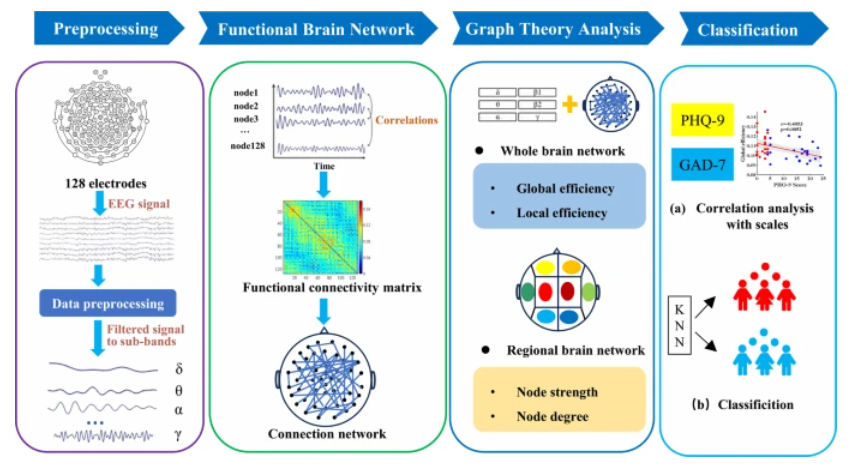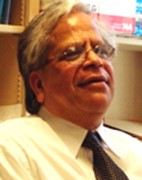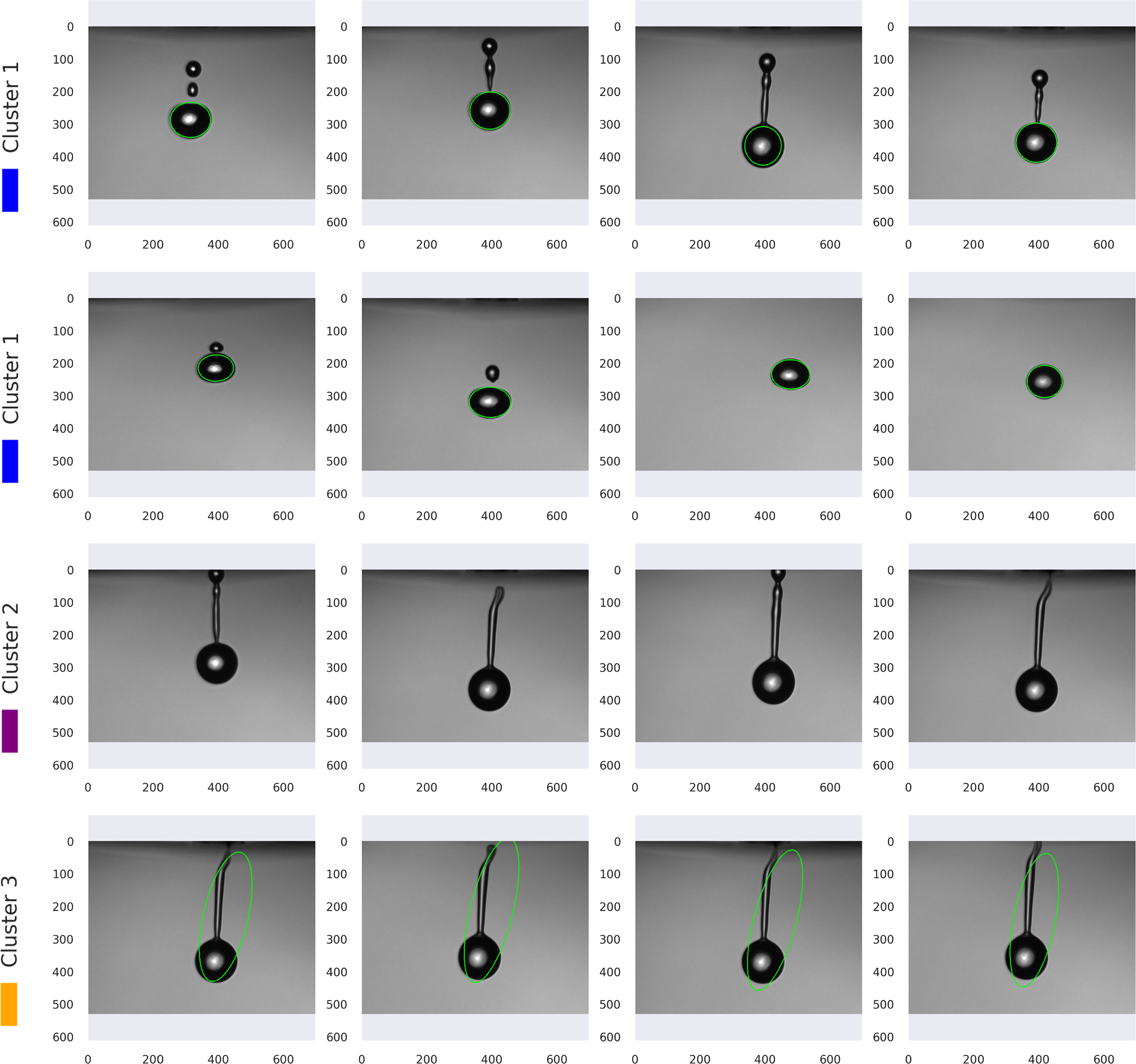News / Highlights / Colloquium
EPJ ST Highlight - Functional brain networks disrupted in major depression
- Details
- Published on 23 July 2025

A detailed analysis of functional brain networks from individuals with and without major depressive disorder using graph theory has revealed subtle but significant differences between these groups that could aid early diagnosis of this devastating condition.
Severe depression or major depressive disorder (MDD) is the commonest serious mental disorder, and its high and growing prevalence – it is thought to affect over 300 million people worldwide – represents a major societal challenge. Many studies have shown some characteristic patterns in brain structure and activity in depressed individuals, but the details and the likely reasons are unknown. Now, however, an interdisciplinary group of researchers led by Mengmeng Du of Shaanxi University of Science and Technology, China, have used the mathematical technique of graph theory to analyse networks of brain activity in different regions and at different scales. This work has been published in the journal EPJ Special Topics (EPJ ST).
EPJ ST: Nuggehalli M. Ravindra new Editor on board
- Details
- Published on 17 July 2025

The publishers are very pleased to announce that Dr. Nuggehalli M. Ravindra (Ravi) has recently joined the EPJST Editorial Board.
N M Ravindra (Ravi) is Professor of Physics at the New Jersey Institute of Technology (NJIT). He was the Chair of the Physics Department (2009-13) and Director, Interdisciplinary Program in Materials Science and Engineering at NJIT (2009-2016). Ravi is the Founding Editor of Emerging Materials Research. He has been a frequent Guest Editor of several journals including JEM, the Journal of Electronic Materials; JOM, Polymers for Advanced Technologies and MDPI Journals. Before joining NJIT in 1987, Ravi had been associated with Vanderbilt University, the Microelectronics Center of North Carolina (MCNC), North Carolina State University, Abdus Salam Center for Theoretical Physics (formerly ICTP, Trieste), Politecnico di Torino, CNRS associated labs in Paris and Montpellier. Ravi holds a PhD in Physics from Indian Institute of Technology (Roorkee, India), MS & BS in Physics from Bangalore University, India. Ravi and his research team have published over 350 papers in international journals, books and conference proceedings and 8 Books; his team has three issued patents; he has organized over 40 international conferences; and he has given over 80 talks in international meetings.
Ravi's research interests include devices, education, energy storage, materials, manufacturing, optical coatings, renewable energy, semiconductors and sensors.
EPJ ST Highlight - Data-Driven Insights into Inkjet Droplet Formation
- Details
- Published on 09 July 2025

High-speed image analysis shows how the control parameters of inkjet printers are linked to the shapes of the ink droplets they produce – helping researchers to optimise the printing process.
Inkjet printing has become a cornerstone of high-tech microfabrication, underpinning applications ranging from microchip production and drug delivery to DNA sequencing and tissue engineering. In these fields, precision is paramount - the ability to reliably place picolitre-sized droplets with exact morphology determines the success of both medical treatments and microelectronic device fabrication.
Despite advances in computational fluid dynamics (CFD), simulating and controlling droplet formation in real-world conditions remains a challenge due to the complexity of two-phase flows and the vast number of operational parameters involved. To address this, researchers are turning to data-driven approaches as a complementary or alternative strategy. These methods can reduce reliance on time-consuming simulations and enable real-time analysis and decision-making in manufacturing environments.
In a new study published in EPJ Special Topics (EPJ ST), researchers at CIMNE/UPC present a comprehensive data-driven investigation of droplet morphology in inkjet printing. The team, led by Pavel Ryzhakov, began by performing extensive controlled droplet-generation experiments using a piezoelectric inkjet dispenser. Each droplet was captured via high-speed imaging, yielding a rich dataset of raw images and extracted geometrical features.
EPJ ST Highlight - Dynamics of fluid flow on (and off) inclined fibres
- Details
- Published on 10 February 2025

An empirical analysis of oil flowing down an inclined fibre has suggested how the structure and dynamics of droplet formation and drop-off is affected by the multiple forces involved in this deceptively simple phenomenon.
The commonplace phenomenon of liquid drops falling from a surface is, perhaps surprisingly, not yet fully understood by scientists. Understanding the complex interactions between the forces involved here would be helpful in industry, where structured packings in cooling towers must be designed to encourage droplet formation in fluid flow but coatings mixed to maintain a pristine, smooth surface. Furthermore, the design of meshes used to harvest clean water from fog or dew, where this is limited, relies on an understanding of how the water condenses on the fibres and drops into collection tanks.
Atefeh Pour Karimi, a PhD student at the Institute of Heat and Mass Transfer, Aachen University, Germany and her supervisors and collaborators have analysed the dynamics of this type of flow in detail and published their findings in the journal EPJ Special Topics (EPJ ST).
EPJ ST Highlight - New call-to-action empathises scientists’ role in combating climate change
- Details
- Published on 03 February 2025

This first paper published in the special issue on Energy Saving in Physics Research and Applications in EPJ Special Topics looks at the roles of science on universe and matter and digital transformation in the ongoing battle to reduce global temperature.
“Climate change is real.” That stark and undeniable statement spearheads a new call to action in a paper published in a special issue of EPJ Special Topics (EPJ ST), focusing on energy saving in physics research and applications. This call to action doesn’t outline a general package of measures and daily life recommendations to aid in efforts to limit rising global temperatures, rather it specifically focuses on the use of resources by scientists conducting research, particularly in the field of universe and matter. The paper advocates the use of digitisation methods to potentially offset resource consumption without sacrificing knowledge gains.
EPJ ST Highlight - Assessing the impact of climate on dengue outbreaks
- Details
- Published on 13 December 2024

Machine learning techniques reveal that researchers can improve their forecasts for the spread of dengue by incorporating climate data – but not in all cases
Dengue is a mosquito-borne disease which infects around 390 million people globally each year. Case numbers have grown steadily in recent years, with the most severe outbreaks occurring in tropical regions of South America. To better predict how the disease spreads, it will be vital for researchers to fully understand how dengue case numbers are linked to different aspects of tropical climates.
Through new analysis published in EPJ Special Topics (EPJ ST), a team led by Enrique Gabrick at the Potsdam Institute for Climate Impact, Germany, highlight how dengue forecasts can become more accurate by incorporating climate data – but also show that the success of this approach can vary between different regions. The team’s results could enable researchers to develop more accurate forecasts for the spread of dengue, which may ultimately help to save thousands of lives.
EPJ ST Highlight - Taking a step back from the membrane debate
- Details
- Published on 10 December 2024

New progress in a long-standing debate about the nature of biological cell membranes could be made by considering which aspects of the membrane can be captured in simplified simulations
Even after 60 years of exhaustive experimentation and modelling, researchers still haven’t reached a consensus about the true nature of the deeply complex behaviours of biological cell membranes. Today, many disagreements remain over how the membrane’s molecular building blocks cooperate with each other to produce its overarching properties.
Through a new mini-review published in EPJ Special Topics (EPJ ST), John Ipsen at the University of Southern Denmark takes a step back from the debate: showing how complications to the discussion have emerged from the practices widely used to simulate the membrane. The insights presented in his paper could offer useful guidance for researchers, and may help to break a long-standing deadlock in their conflicting interpretations of the membrane’s properties.
EPJ ST Highlight - Modelling Brain Networks in Parkinson’s Disease
- Details
- Published on 18 November 2024

Insights from network theory have led to a novel mathematical representation of Parkinson’s disease development with potential clinical applications
Neurodegenerative diseases, such as Parkinson’s disease, can be thought of as arising from malfunctions in the network of neuronal agglomerates in the brain. It is therefore often useful to apply insights from a branch of mathematics called network theory when studying the development of these diseases. A group of European physicists and engineers led by Maria Mannone of the National Research Council of Italy, the University of Potsdam, Germany, and the Potsdam Institute for Climate Impact Research (PIK), Germany, has now taken this further by defining a matrix transforming the brain network of a healthy individual into one affected by Parkinson’s disease. This has now been published in EPJ Special Topics (EPJ ST).
EPJ ST Highlight - A mathematical approach to simulating electromagnetic field of ReBCO superconductors
- Details
- Published on 15 November 2024

Electromagnetic field and alternating current loss in high-temperature ReBCO superconductors can be obtained by treating their complex electromagnetic interactions as a convex optimisation problem
Rare-earth barium copper oxides (ReBCO) are a family of superconducting materials that allow electrical currents to flow with zero resistance, even at temperatures well above absolute zero. This allows them to sustain stronger magnetic fields than other type of superconductors. However, these materials often host a complex nonlinear electromagnetic response. So far, it is a challenge to deal with the electromagnetic problem of ReBCO superconductors accurately and efficiently.
Through new research published in EPJ Special Topics (EPJ ST), Huadong Yong and colleagues at Lanzhou University, China, show that the electromagnetic problem with power law relation can be approached as a mathematical challenge known as a ‘convex optimisation problem’. By applying this problem-solving method, the team was able to accurately calculate the electromagnetic field and alternating current loss for a variety of real-life superconducting structures.
EPJ ST Highlight – Observing Flows at a Liquid-Liquid-Solid Intersection
- Details
- Published on 21 June 2024

Experiments reveal how a liquid-liquid interface interacts with a moving contact line.
Most of us are familiar with the classic example of a liquid-gas moving contact line on a solid surface: a raindrop, sheared by the wind, creeps along a glass windscreen. The contact line’s movements depend on the interplay between viscous and surface tension forces - a relationship that has been thoroughly investigated in experimental fluid mechanics. In a study published in EPJ Special Topics (EPJ ST), Harish Dixit, of the Indian Institute of Technology Hyderabad, and his colleagues now examine the movements of a contact line formed at the interface between two immiscible liquids and a solid. The experiments fill a gap in fluid dynamics and suggest a mechanism for an imposed boundary condition that eludes mathematical description.




